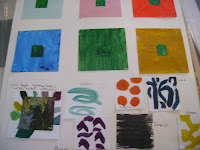









I chose work from four artists Matisse Klee Picasso and Van Gogh as the starting points for this exercise. Using water colour crayon and collage techniques I explored images from sections of the work through a 5cm viewer and then let my work get a little larger as I went on.
I chose Matisse because he had arrived at the start of this module when I watched the t.v programme about him. Also his vibrant colour and use of shape is wonderful. The resulting shapes kept taking me underwater to the sight of wonderful kelp beds and coral reefs I have swum amongst here and in New Zealand. Smooth texture fluidity movement are all things I wanted to capture.
The Van Gogh piece on willows is because I planted 400 willows this Spring and their colours and forms are just starting to develop and cause me great excitement ! I struggled to capture the depth of colour in my pieces
Picasso was chosen because here was a woman's figure with wonderful representation of textiles on her and I loved the colour combination - gold black and red. Again my pencils were used with too little pressure and lacked depth of colour but I liked some of the shapes which reminded me of musical notation / scores.
And finally Klee's The Goldfish. I love the colours and mysterious depths of this work and enjoyed working with it.
My own interpretations were primarily from Matisse but I suspect a lot of the emotion of Klee was there for me as my shapes became like coral and seaweed. I loved the coral like ribbons produced with coloured charcoal.
The aquarelle crayon on wet watercolour paper was a good way to explore shadowy effects and then the joy of simple shapes on dark background and the mosaic / stained glass window piece.(This is best seen up against a light source)
I am still thinking about shadow and coloured shadows so cut out the simple c shape and stuck them onto card tubes to catch a shadow underneath, which I painted in. I realise it will get squashed during postage but hope you see the effects.
Finally I wanted to think about white holes or space so chose to crayon in some coloured bands and impose white shapes onto it. Not a great effect but worth a try.
On the whole fun and I was glad to try and decide whether shape / movement or colour was most important to me as I did each piece.











































